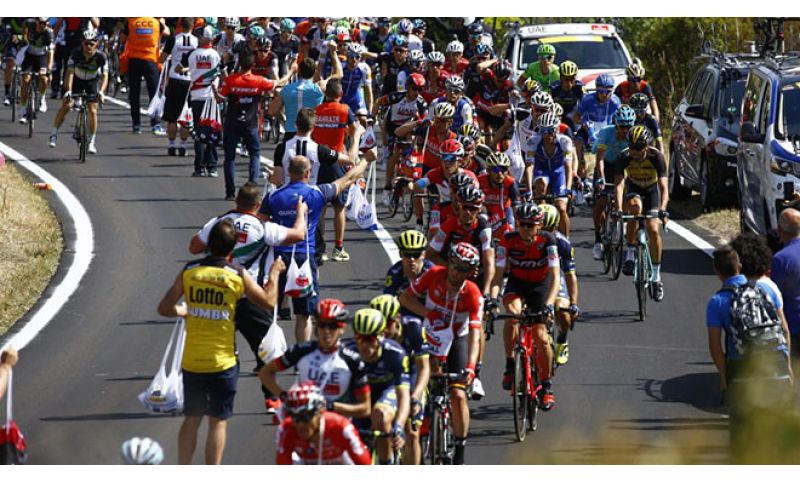

As the UCI Women’s WorldTour gets under way - the Santos Tour Down Under in Australia (17-19 January) - the Union Cycliste Internationale (UCI) would like to provide an update on the progress of the initiatives it has launched to improve safety in women's and men’s road races.
As a reminder, SafeR is the structure dedicated to safety in men's and women's road cycling. It brings together representatives of all stakeholders in road cycling – organisers (Association Internationale des Organisateurs de Courses Cyclistes - AIOCC), teams (Association Internationale des Groupes Cyclistes Professionnels - AIGCP), riders (Cyclistes Professionnels Associés – CPA, and CPA Women) and the UCI in particular. SafeR is made up of three bodies: a Supervisory Board, a dedicated commission and a Case Management Committee. The Supervisory Board meets four times a year to take strategic and budgetary decisions. The SafeR Commission meets monthly to advise on matters such as regulations, equipment and education. Finally, the Case Management Committee meets weekly to review race incidents, anticipate issues for upcoming races and conduct safety audits of teams and races.
The composition of the three SafeR bodies mentioned above is currently as follows:
SafeR Supervisory Board
SafeR Commission
SafeR Case Management Committee (composed of analysts put forward by each association, with the UCI acting as an observer)
One of the key principles of SafeR is to make decisions based on data collected from races. For 2024, the data collected through the UCI race incident database was enhanced to ensure not only exhaustivity but clear categorisation of incidents, which will support policy decisions being made. In total, 497 incidents were registered in 2024 at UCI WorldTour, UCI Women's WorldTour and UCI ProSeries (men's and women's) events. Besides unprovoked rider errors which represent 35% of incidents, other major contributing factors for incidents include situations of tension generated by the approach of tactically important points of interest in the race such as climbs, cobbled sectors or sprints (13%) and hazardous road conditions, in particular wet and slippery roads, (11%). Road infrastructure, poor road conditions and vehicle behaviour were the cause of 9%, 4% and 1% of recorded incidents respectively.
The UCI race incident database, established in collaboration with Ghent University, Belgium, has provided some essential insights when it comes to:
This groundwork is essential for SafeR to identify topics on which recommendations shall be made and where concrete improvements can be made. Whereas the data is collected in a limited number of events, the objectives of SafeR are for safety improvements to be cascaded at lower levels of racing as well.
As a result of recommendations made by SafeR in 2024, the UCI, in collaboration with the stakeholders of women’s and men's road cycling, launched a test phase during the second half of the 2024 season of various measures likely to improve rider safety: introduction of a yellow card system, adaptations to the way earpieces are used and changes to the protocols applying to the sprint zone. This phase met with general satisfaction and enabled progress to be made towards changes to rules and protocols that will enhance safety in cycling races.
With regard to the sprint zone, a consensus emerged in favour of adapting the protocols in force in the direction of the measures tested. The Professional Cycling Council (PCC) and the UCI Management Committee approved the continuation in 2025 of the protocol tested in 2024.
Under the new protocol for bunch sprint stages, the so-called ‘three kilometre rule’ can be extended to a maximum of five kilometres, at the request of the organiser and subject to the approval of the UCI. When a rider enters the zone leading to the final sprint and is the victim of a duly recorded incident (e.g. a fall, mechanical problem or puncture) in the last three to five kilometres of a road stage (excluding summit finishes), depending on what has been determined prior to the stage, the rider will be credited with the time of the rider(s) they were riding with at the moment of the incident. The aim of this measure is to take account of the increasing number of traffic calming devices (e.g. speed bumps, curb extensions, road narrowings) - sources of danger for the peloton - within an ever-greater radius of the race finish sites in urban centres. Extending the zone in which the rule applies reduces the pressure on riders during the phase of the race leading up to the final sprint.
The method of calculating time gaps for stages with a bunch sprint finish was also simplified in the new sprint zone protocol. Until now, the time difference calculation rule meant that the same time was allocated to riders in the same group as long as no more than one second separated two riders following each other (in other words, if there was a gap of one second or more between two riders, the time of the riders in the second group was calculated on the basis of the gap separating the first rider in each group at the finish line). With the simplified method, the time calculation gap is increased to three seconds for riders in all groups in the race, with the sole exception of clearly established breakaways. The aim of this change is to simplify the calculation of time gaps at stages with an expected bunch sprint finish, and to relieve the pressure on riders not directly involved in the sprint by allowing them to leave a certain margin with the front of the race, thus giving more space to the teams leading out their sprinters for the stage win.
SafeR also took the initiative of organising a Sprint Finish Survey, which collected feedback from 174 riders on topics ranging from course design to rider behaviour. Based on the outcome of the survey, a working group with riders was organised to discuss their concerns directly. The meeting covered course design, barriers, rider behaviour, regulations and officiating. A key message from the riders is the utmost need for consistency in the application of sanctions for dangerous rider behaviour in sprint finishes (e.g. deviating from their line in a dangerous manner and not checking their surroundings) both by sprinters and lead-out riders. This information was communicated to the UCI International Commissaires during their annual seminar this week and clarifications have been made to the infractions related to sprints to clearly cover lead-out riders as well. During the working group, the riders expressed their concerns about course design in sprint finishes, namely poorly positioned and aligned barriers, the entry to the vehicle deviation and the need to avoid corners in the last sections. This discussion was constructive, and organisers will be responsible for respecting the current regulations, while SafeR will continue discussing future recommendations to be implemented.
With regard to the use of earpieces, two methods of use were tested: only two riders per team wearing an earpiece, and blanket removal of the device. Different stakeholders then answered a questionnaire to give their opinion on these two methods. The UCI received a total of 349 completed questionnaires (including from 240 riders and 42 team representatives in men’s cycling). This operation led to a better understanding of the advantages and disadvantages of the use of earpieces and more broadly in-race communication in the race convoy. The aim is to ensure that any future testing and potential changes to the current rules and usage meet the imperative of increasing safety. This could involve improvements to devices and technology used to ensure the efficiency of in-race communications for riders, teams, organisers and officials.
The subject of communication during the race between all those in the race convoy will be part of an in-depth study to determine where improvements can be made to strengthen the monitoring of the race for the safety of riders and all involved. To achieve this objective, consultations are underway with various service providers to adapt solutions that have already been implemented in other sports where radio communication is used to enhance safety.
The yellow card system was tested at UCI WorldTour and UCI Women's WorldTour events. A total of 31 yellow cards were issued over 66 race days, to riders (52% of cases), team staff (32%) and media vehicle drivers and pilots (16%).
The successful completion of the test phase allows the full regulations to come into force for the 2025 season with modifications based on input from the SafeR Commission. This includes adding more events, in addition to UCI WorldTour and UCI Women’s WorldTour events, during which yellow cards can be issued: UCI Road World Championships, UCI ProSeries events and Continental Championships, as well as the addition of two further infractions for which yellow cards can be issued. It will now also be possible to issue a yellow card for dangerous behaviour of a lead-out rider in sprint finishes, and also to a team assistant in the feed zone who attempts to feed their riders in a dangerous manner.
The yellow card system is explained in this video.
The SafeR Commission also recommended changes to the feed zone regulations. For the 2025 season, the requirement is for organisers to install a feed zone approximately every 30 to 40 kilometres in conjunction with litter zones. This change removes a provision introduced as a specific measure during the Covid-19 pandemic that allowed open feeding along the race route. Returning to fixed feed zones with improved set-up requirements, will increase safety and equality between the teams.
Following a study that highlighted weaknesses when it comes to safety of some of the barriers used by event organisers, SafeR will launch the second phase of the study that will define the specifications and approval methods for barriers to be used in the last 500 metres of races. At the end of this study, SafeR and the UCI will publish a document containing requirements concerning, in particular, the dimensions of the barriers, their mechanical characteristics, their fixing systems, the way in which advertising panels are fixed to them and the impact tests required for their approval. The second phase of the study is anticipated to be completed in six months’time, and the UCI will announce the publication of the document.
In addition to the topics detailed above, a wide range of areas concerning the safety of road races are also being studied by SafeR. These include course evaluation software to improve how race routes are selected and how the courses are prepared with course protection, for example padding and signalisation of hazards such as beach flags and safety totems that enhance the visual warnings for riders.
Various types of equipment-related solutions to enhance safety are also being analysed, such as the use of rider airbags, the regulations concerning rim height and handlebar width, and consideration of gear restrictions to reduce top speeds.
The feasibility of a device to measure the distance between riders and vehicles in the race convoy is also being studied.
More details on these projects will be explained in future announcements made by SafeR.
An online press conference will be held on Thursday 6 February at 14h00 CET with the participation of members of SafeR representing the UCI and stakeholders of women’s and men’s professional road cycling. Journalists wishing to attend this press conference will be able to join via this link.
UCI President David Lappartient said: “The safety of riders is a priority, both for the UCI and for all those involved in men's and women's cycling. Launched in 2023, SafeR now has a solid structure and is progressing with rigour and professionalism towards the implementation of initiatives that will make road cycling safer for its key players, the riders.
“The tests carried out to evaluate various measures developed by SafeR demonstrate not only the obvious need to develop our rules and protocols, but also our excellent collaboration with organisers, teams and riders. We are all united in the cause of safety and will continue to make progress in this direction in 2025 and beyond.”
